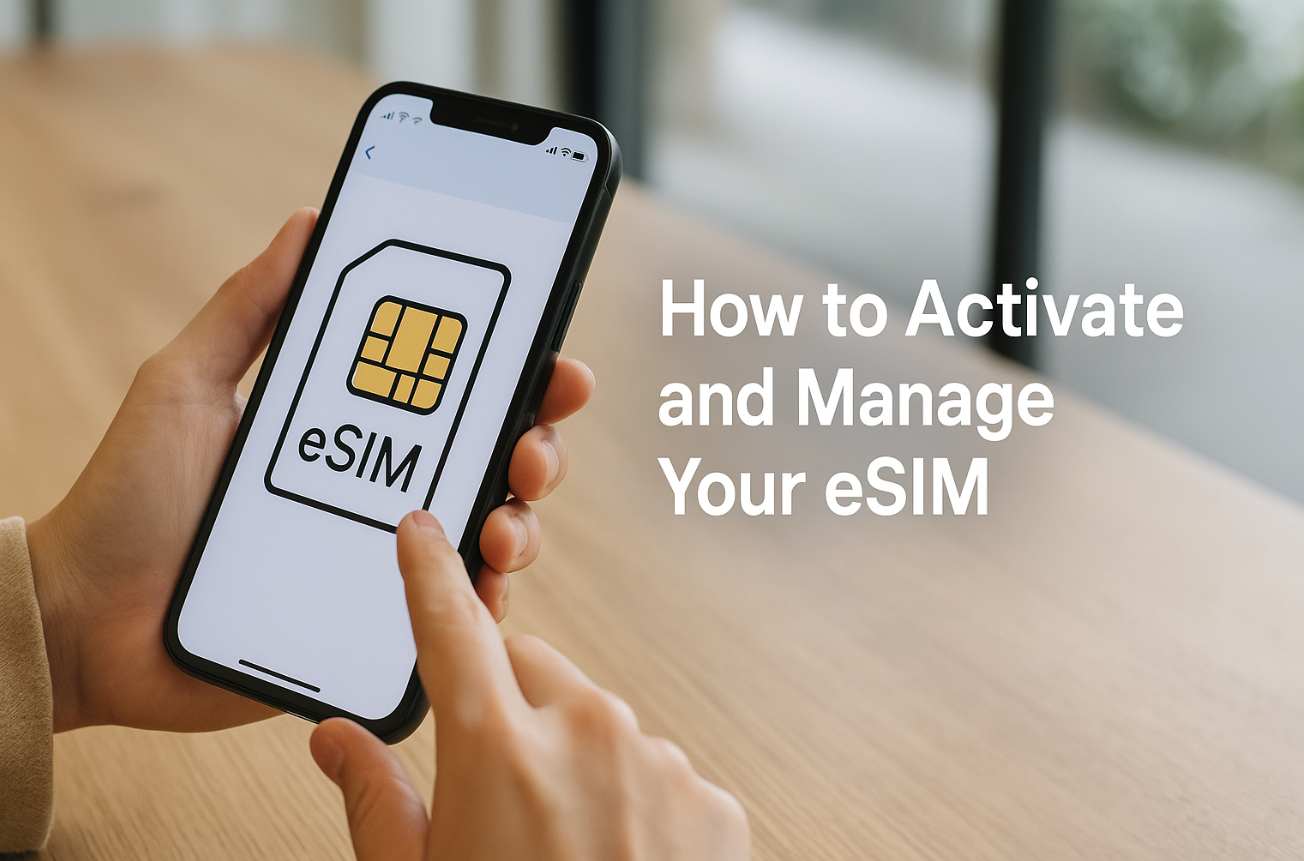The world of mobile connectivity is evolving, and eSIM technology is at the forefront of this transformation. Gone are the days of fumbling with tiny SIM cards or dealing with complicated activation processes. With eSIMs, you can enjoy seamless connectivity without any physical SIM card limitations. Whether you’re traveling abroad or simply looking to switch carriers effortlessly, understanding how to activate and manage your eSIM is essential.
This guide will walk you through everything you need to know about eSIMs—from what they are and how they work to step-by-step instructions for activation and management. Say goodbye to the hassle of traditional SIM cards; it’s time to embrace the future!
1. What is eSIM?
An eSIM, or embedded SIM, is a digital version of the traditional SIM card. Unlike physical SIM cards that you insert into your device, an eSIM is built directly into the hardware. This technology allows for more flexibility and convenience in managing mobile connections.
eSIMs enable users to switch carriers without needing a new physical card. They can be programmed remotely by service providers, making it easier to activate plans while traveling or changing networks. As smartphones and devices evolve, eSIM technology becomes increasingly popular for its seamless integration and user-friendly experience.
2. How eSIMs work
eSIMs, or embedded SIM cards, function differently from traditional SIM cards. Instead of being a physical card that you insert into your device, an eSIM is built directly into the hardware. This allows for easier activation and management without needing to swap out physical cards.
When you activate an eSIM, your mobile carrier sends over a digital profile containing all necessary information for network connectivity. This can be done through apps or QR codes. The process simplifies switching carriers or plans and provides flexibility when traveling internationally without hassle.
3. Benefits of using eSIM
eSIM technology offers several advantages over traditional SIM cards. One of the most significant benefits is convenience. With an eSIM, you can switch carriers or plans without needing to physically change your SIM card. This flexibility makes it easier for travelers to find local networks and save on roaming fees.
Another key benefit is space efficiency within devices. Since eSIMs are embedded in the device itself, manufacturers can design slimmer gadgets with more room for other features like larger batteries or enhanced cameras. Additionally, eSIMs contribute to a more sustainable future by reducing plastic waste associated with physical cards.
4. eSIM Activation and Setup
Activating and setting up your eSIM is a straightforward process. First, you need to download the necessary apps from your device’s app store, typically provided by your mobile carrier. These apps often guide you through the activation steps seamlessly.
Next, select an appropriate plan based on your destination or usage needs. Once you’ve chosen a plan, follow the instructions to install and activate the eSIM profile on your device. This may involve scanning a QR code or entering information manually depending on your carrier’s requirements for setup.
Downloading the necessary apps
To activate your eSIM, the first step is to download the necessary apps specific to your mobile carrier. These applications often streamline the setup process and provide essential information about plans and services. Check your device’s app store for these official apps.
Once downloaded, open the app and create an account if required. This will help you manage your eSIM settings easily. Ensure that you have a stable internet connection during this process for a smoother experience. Having everything ready will make activating your eSIM straightforward and efficient.
Selecting a plan and destination
Choosing the right plan for your eSIM is crucial, especially if you travel frequently. Begin by researching various providers to find options that suit your needs. Look for plans that offer good data limits and coverage in your destination country.
Consider whether you need a short-term plan for a quick trip or something more long-term. Be mindful of roaming fees and check if the provider offers local rates at your destination. This will ensure optimal connectivity without unexpected charges while you’re on the go.
Installing and activating the eSIM
To install and activate your eSIM, start by accessing the settings on your device. Navigate to the Mobile or Cellular section, where you will find an option to add a new plan. This is where you’ll enter the information provided by your carrier.
Once you’ve entered the details, follow any on-screen prompts to complete activation. Your device may require a restart for changes to take effect. Afterward, check if the eSIM appears in your mobile plans list and ensure it’s selected as active for data usage and calls.
6. eSIM Activation Methods
Activating your eSIM can be done in two primary ways: using QR codes or manually entering the eSIM information. Most carriers provide a QR code that you can scan with your device’s camera, making activation quick and straightforward. This method is user-friendly and often the preferred choice for many users.
Alternatively, if you don’t have access to a QR code, you can enter the details manually. You’ll need your activation code and other relevant information from your carrier. While this method might take slightly longer, it offers flexibility if you’re facing technical difficulties with scanning.
Using QR codes
One of the most convenient ways to activate your eSIM is by using QR codes. When you purchase an eSIM plan from a provider, they typically send you a unique QR code via email or SMS. This code contains all the necessary information for installation.
To activate, simply open your device’s settings and select “Add Cellular Plan.” Use your camera to scan the QR code. The system will automatically download and configure your eSIM profile, making it ready for use within moments. It’s quick and efficient, eliminating complicated manual setups.
Manually entering eSIM information
If you prefer not to use a QR code for eSIM activation, manually entering the information is a viable option. Start by accessing your device’s settings. Navigate to the cellular or mobile network section and select “Add Cellular Plan.”
You will need to input details such as the SM-DP+ address, activation code, and any additional credentials provided by your carrier. Ensure that all information is entered accurately to avoid connectivity issues. Once completed, confirm the setup and enjoy seamless access to network services without needing a physical SIM card.
7. Transferring eSIM from different devices
Transferring an eSIM from one device to another is a straightforward process, but it varies by carrier. Generally, you need to deactivate the eSIM on your old device before activating it on the new one. This ensures that your mobile service remains uninterrupted.
To transfer, start by accessing the settings of your current device and selecting the option to remove or deactivate your eSIM profile. Then, follow your carrier’s specific instructions for reactivating it on the new device, which may involve scanning a QR code or entering activation details manually.
8. Managing eSIM with Dual SIM functionality
Managing eSIM with Dual SIM functionality allows users to enjoy the benefits of two phone numbers on a single device. This setup is ideal for maintaining personal and work contacts, or for travelers who want local data plans while keeping their primary number active.
You can easily switch between your physical SIM and eSIM through your device settings. Most smartphones featuring Dual SIM capabilities allow you to customize preferences for calls, messages, and mobile data usage. This flexibility enhances convenience without sacrificing connectivity or the need to carry multiple devices.
9. Available eSIM providers and plans
Several major carriers now offer eSIM plans, making it easier to switch and manage your mobile service. Providers like AT&T, T-Mobile, and Verizon in the U.
S. have embraced this technology. Internationally, options include Vodafone and Orange in Europe, as well as Telstra in Australia.
Beyond traditional carriers, many virtual operators also provide competitive eSIM plans. Companies such as Airalo and GigSky focus on travelers seeking affordable data packages for specific destinations. With a variety of offerings available, you can select an eSIM plan that best suits your needs while enjoying flexibility and convenience.
10. Frequently Asked Questions about eSIMs
Understanding eSIM technology can seem overwhelming at first, but common questions can clarify things.
What is an eSIM? An embedded SIM allows you to activate a cellular plan without needing a physical SIM card.
Can I use an eSIM internationally? Yes! Many international carriers support eSIMs, making it easier to switch plans while traveling.
Are all phones compatible with eSIM? Not yet. Check your device specifications to see if it supports this feature.
How many profiles can I store on my eSIM? Most devices allow multiple profiles, though only one can be active at a time.
Is data sharing possible with an eSIM? Absolutely! You can share your data connection just like you would with a traditional SIM card.
By addressing these queries, users will feel more empowered and informed about transitioning to or managing their current eSIM setup effectively.

